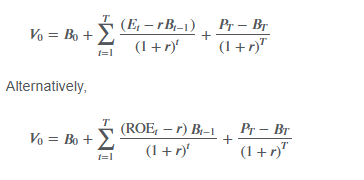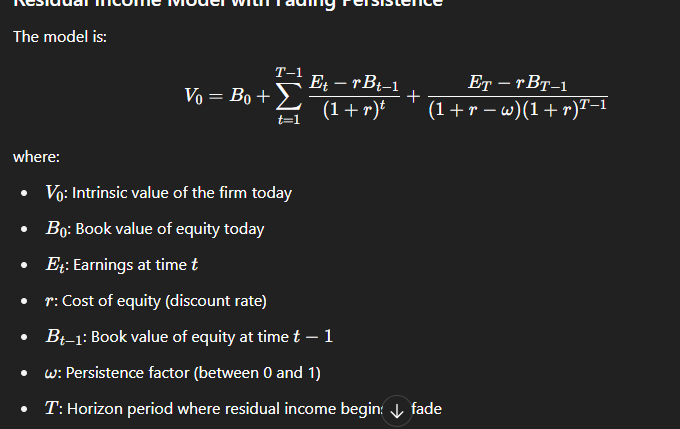Equity Valuation
1/63
There's no tags or description
Looks like no tags are added yet.
Name | Mastery | Learn | Test | Matching | Spaced |
|---|
No study sessions yet.
64 Terms
How attractive is the industry ?
Porter 5 forces
Pestel
What is the company position in the industry (Business model) ?
Cost Leadership
Differentiation
Focus
How well was the strategy executed ?
How the financials reflect the strategy
How to analyse the cost structure
Profit Margin
High proportion of accrual in earnings
Low quality earning
Research Format report
Table of content
Executive summary
Business summary
Risks
Valuation
Historical & ProForma table
When to apply a DDM
The company pays dividends
There is a dividend policy
The investor takes a no control perspective
When to Use Free Cash Flow models
No/Unstable dividends
Easy to forecast
The investor takes a control perspective
Present Value of Growth opportunity in DDM
Vo = E1/R + PVGO or P/E = 1/r + PVGO/E1
Forward P/E
P/E = Payout ratio / (r-g)
H model DDM
Vo = (D0(1+g1) + DoH(g0-G1)) / (r-Gg1)
growth rate of dividends
g = Retention ratio x ROE
Free Cash Flow To Firm general formula
FCFF = NI + NCC + Int(1-t) - CAPEX - Change in WC
Free Cash Flow to firm from CF Statement
CFO + Int (1-t) - CAPEX
From FCFF to FCFE
FCFE = FCFF - Int(1-t) + net borrowing
FCFF from EBIT
EBIT(1-t) + D&A - Change in WC - CAPEX
FCFF from EBITDA
EBITDA(1-t) + D&A(t) - change in NWC - CAPEX
What to do in Non operating assets
Do FCFF calculation on operating and add back non operating asset at market value
Normalised EPS
EPS adjusted for cyclicality
2 methods for normalised EPS
Historical average over full cycle
average ROE x BVPS
Earning Yield
E/P
Prdicted PE factors
Growth rate in earning
payout ratio
standard deviation of earning
PEG
P/E / Growth rate of earning
Own Historical P/E
Justified price = (Benchmark Value of historical P/E) x Most recent EPS
Tangible BVPS
Shareholder Equity - intangible
Justified Forward P/E
Payout Ratio /r-g
Justified Trailing P/E
Payout ratio x (1+g) / (r-g)
Justified P/B Ratio
1+ (ROE - r) / r-g
Justified P/S Based on forecast
Po/S1 = (E1/S1)*Payout ratio / (r-g)
Justified Trailing P/S ratio
Po/So = (Eo/So) x payout ration x (1+g)/r-g
growth rate in P/S ratio
g = retention rate x Dupont decomposition
Scaled earning surprised
EPS surprise/ SD(EPS surpise)
how to average multiple
Use the harmonic mean
Residual income
Residual remaining income after deduction of cost of capital
2 approaches for residual income
Nopat - Capital Charge
Net income - Equity charge
Economic Value Added Formula
NOPAT x (C% x TC)
NOPAT adjustment in EVA Calculation
R&D is added back to earning
Charge for capital can be suspended
deferred tax are eliminated
LIFO reserve is added back to capital
Operating lease are treted as capital lease
Market Value Added
Market Value - Book Value
Residual income model
Book Value + Discounted residual income
RIM Formula
Bo + Somme(Et -rBt-1)/(1+r)^t
Excess earning method
Bo + Somme(( ROEt - r) Bt-1)/ (1+r)^t
Single stage dividend model for residual income
Vo = Bo + (ROE- r)/(r-g) x Bo
Tobin s q
Market Value of debt and equity / Replacement cost of asset
Multistage residual income valuation

Residual income with fading persistence

When to use a RMI model
A company do not pay dividends
FCF are negtive
Uncertainty around the terminal value
3 important topics in private valuation
Normalised earnings
Discount rate
Valuation Discount/Premium
expanded CAPM
An adaptation of the CAPM that adds to the CAPM a premium for small size and company-specific risk.
Discount for lack of control
1 - (1/1+control premium)
Discount for lack of marketability
At the money put option premium as a % of the stock
Total discount for DLOC ant DLOM
(1 - (1-DLOC) x (1- DLOM))
Re investment rate
g / WACC
Firm Value for private company from NOPAT
EBIT (1-t) (1-RIR) / (WACC - g)
Excess earning method for private company
DDM but D= Normalised income - WC x cost WX - Fixed asset x cost of fic=xed assets
Unlevering Beta
Bu = Bl / (1 + (1-t) x D/E)